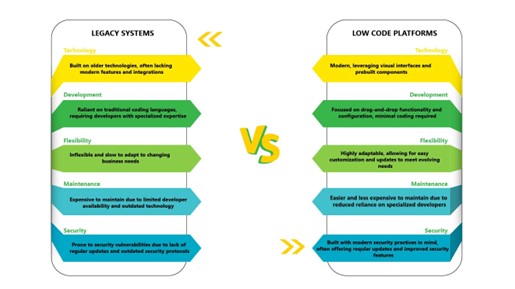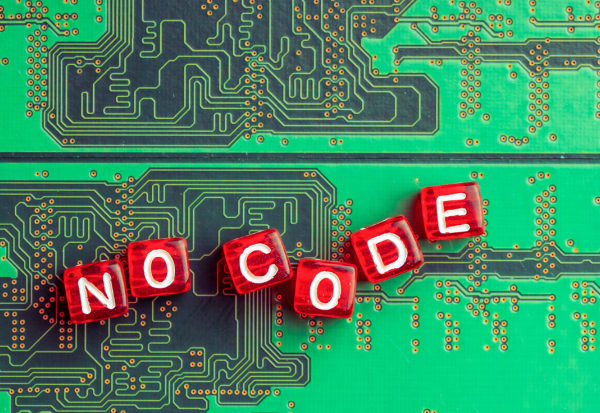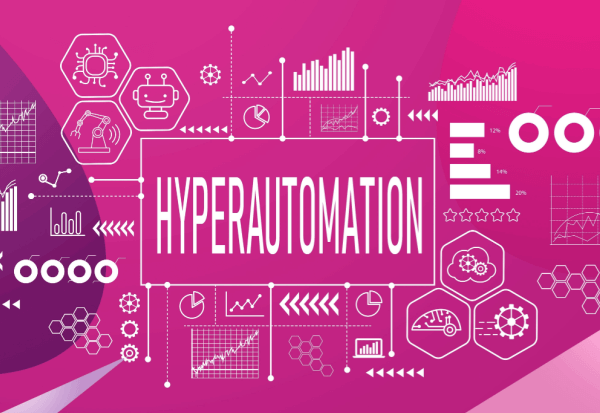In today’s rapidly evolving digital landscape, legacy applications can often become cumbersome burdens. Built with outdated technologies and struggling to keep pace with changing business needs, these applications can hold back efficiency and innovation. But what if there was a way to modernize and regenerate these legacy systems without the high costs and complexities of traditional development?
Enter low-code development – a revolutionary approach that empowers businesses to build and deploy applications with minimal coding. This powerful technology offers a compelling solution for migrating legacy applications and steering them into the new era.
Low-Code as a Modernization Tool:
Low-code development platforms offer a visual and native approach to building applications, allowing businesses to:
- Modernize functionalities: Leverage pre-built components and drag-and-drop features to rebuild functionalities with modern features and improved user experience.
- Reduce development time and costs: Minimize the need for extensive coding, leading to faster development cycles and reduced development costs.
- Empower citizen developers: Business users with limited coding experience can contribute to the migration process, leveraging their domain expertise.
- Improve agility and scalability: Easily adapt and scale the application as business needs evolve.
By leveraging low-code power, organizations can breathe new life into their legacy applications, transforming them into modern, efficient, and secure solutions that support their continued growth and success.

When is the Right Time for Modernizing Legacy Applications?
Below is the list of signs indicating your business needs legacy application modernization:
- Difficulties in maintaining or updating, increasing IT costs in both time and staff.
- Code bloat or hacked integrations can lead to performance issues, instability, or bottlenecks in scaling.
- Code bloat in monolithic apps or undocumented code elements makes it difficult for new IT staff.
- Third-party elements of the application may no longer be supported.
- The application may not interact with newer systems.
- The system is no longer agile to emerging customer needs.
- Potential security or compliance risks.
If you encounter any of these signs in your legacy technology, it’s time you consider business application modernization.
Migrating to a Low-Code Platform: A Step-by-Step Guide
Legacy systems can become a burden, hindering innovation and agility. Migrating to a low-code platform offers a compelling solution, but navigating the process requires careful planning. Here’s a breakdown of the key steps involved:

- Assessment and Planning:
- Evaluate your Legacy Landscape: Identify the applications you want to migrate, considering complexity, criticality, and user base.
- Define your Goals: What do you hope to achieve with the migration? Improved functionality, faster development, or reduced costs?
- Select a Low-Code Platform: Research and choose a platform that aligns with your technical needs, budget, and existing infrastructure.
- Assemble your Migration Team: Include IT professionals, business users, and stakeholders with expertise in legacy systems and desired functionalities.
- Prioritization and Scoping:
- Prioritize Applications: Not all applications need immediate migration. Focus on those that offer the most significant benefits or pose the greatest challenges with the legacy system.
- Define Scope for Each Application: Break down the functionalities of each chosen application into smaller, manageable modules for migration.
- Design and Development:
- Leverage Pre-built Components: Most low-code platforms offer a library of pre-built components and functionalities. Utilize them to expedite development.
- Focus on Business Logic: While low-code minimizes coding, some situations require custom code for complex functionalities. Focus development efforts on these areas.
- Ensure Data Integrity: Plan data migration from the legacy system to the low-code platform, ensuring data accuracy and consistency.
- Testing and Deployment:
- Thorough Testing: Rigorously test each migrated module and the overall functionality of the low-code application to identify and address any issues.
- Phased Rollout: Consider a phased rollout to minimize disruption and allow for user feedback and adjustments before full deployment.
- Training and Support:
- User Training: Provide adequate training for end-users on the new low-code application to ensure smooth adoption.
- Ongoing Support: Establish a support system to address post-migration challenges and ensure continued application maintenance.
Key Technologies for Legacy Application Migration
While low-code platforms are a key technology for application migration, several supporting technologies are crucial in ensuring a smooth and successful transition. Here are some of the most important:
- API Management: Legacy applications often lack well-defined APIs for communication with other systems. API management tools can help expose data and functionalities of the legacy system through modern APIs, enabling seamless integration with the low-code platform.
- Data Migration Tools: Migrating data from a legacy system to a low-code platform requires careful planning and execution. Data migration tools can automate the process of data extraction, transformation, and loading (ETL), ensuring data integrity and consistency in the new application.
- Integration Platforms as a Service (iPaaS): For complex integrations between the low-code application and other existing systems, iPaaS can provide a unified platform to manage data exchange and workflows, simplifying the migration process.
- Cloud Computing: Many low-code platforms are cloud-based, offering scalability, flexibility, and easier deployment. Migrating legacy applications to the cloud alongside the low-code transition can further enhance agility and reduce maintenance overhead.
- Containerization: Technologies like Docker can package and deploy low-code applications, ensuring consistent behavior across different environments and simplifying the migration process, especially for microservices-based legacy systems.
- Automation Tools: Repetitive tasks involved in migration, such as testing and deployment, can be automated using scripting tools or robotic process automation (RPA) to streamline the process and minimize manual effort.
Conclusion
- AI-powered Development: Expect low-code platforms to leverage AI for code generation and recommendation tasks, further streamlining development.
- Enhanced Citizen Development: Citizen development capabilities will continue to evolve, empowering a wider range of users to contribute to application creation.
- Focus on Security and Governance: As low-code adoption grows, expect stricter security frameworks and governance models to ensure responsible and secure application development.
By embracing low-code migration, you can breathe new life into your legacy applications, transforming them into modern and efficient solutions that propel your business forward. As technology evolves, this approach will continue to offer even greater power and flexibility, shaping the future of application development.

Vinod Kumar, a seasoned technical manager at CDPA, brings over a decade of expertise to the table. His proficiency lies in handling low-code and RPA technologies, where he has successfully led numerous projects to completion. Vinod excels in strategic planning, team leadership, and problem-solving. His commitment to continuous
learning keeps him at the forefront of technological advancements, driving organizational success through innovative approaches and efficient processes.








